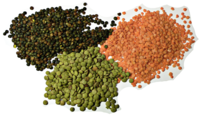
Photo from wikipedia
Abstract Faba beans are an important crops in the agricultural crop rotations and are valuable as medicine, food and feed. Faba beans improve the soil, reduces the utilization of chemical… Click to show full abstract
Abstract Faba beans are an important crops in the agricultural crop rotations and are valuable as medicine, food and feed. Faba beans improve the soil, reduces the utilization of chemical fertilizers for future crops and contribute to the reduction of environmental pollution in agriculture. The aim of this work was to evaluate the potential for environmental mitigation, including the reduction of total greenhouse gas (GHG) emissions from agricultural inputs, and the potential for improving the energy efficiency in faba bean production by managing tillage intensity. Experiments in faba bean production were performed using five tillage methods with different intensities: T-1-C, conventional tillage with deep ploughing at a depth of 23–25 cm (as a control); T-2, shallow ploughing at a depth of 12–15 cm; T-3, deep chiselling at a depth of 23–25 cm; T-4 – shallow cultivation at a depth of 12–15 cm; and NT, no-tillage. The results showed that the replacement of deep ploughing with lower-intensity tillage operations in faba bean production reduced fuel consumption by 9.8–50.8%, total energy consumption by 298–1194 MJ ha−1 and total GHG emissions by 21–128 kg CO2eq ha−1. The highest yields of beans (4.41 Mg ha−1) and energy output (88,133 MJ ha−1) were obtained under treatment T-3, whereas the best energy productivity (0.37 kg MJ−1) and energy efficiency ratio (7.43), and the lowest environmental pollution (481 CO2eq ha−1) were observed under the NT treatment. The analyse of energy efficiency and pollution in this research led to very important findings: less intensive and more soil-friendly tillage practices have a considerable potential for environmental mitigation in agriculture and simultaneously improve energy efficiency without reducing yield.
Journal Title: Energy
Year Published: 2020
Link to full text (if available)
Share on Social Media: Sign Up to like & get
recommendations!